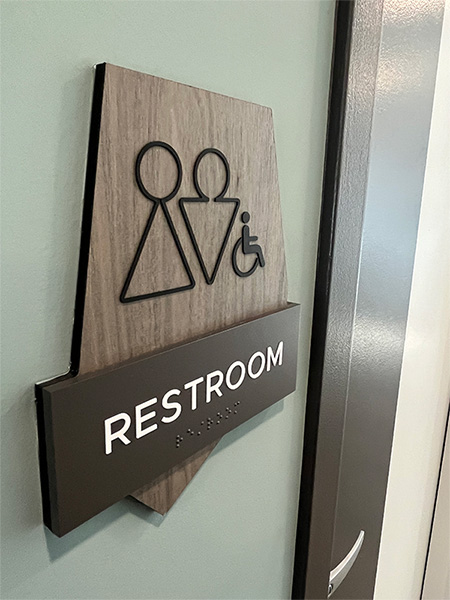ADA / Braille Signs
As per federal regulations, ADA signage requirements apply to public buildings' permanent signage. They're designed to identify, direct or provide information about permanent rooms/features to make navigation easy and enhance physical accessibility for people with disabilities. Placing ADA signage in rooms or spaces is a step in the right direction, but there's much more to it.
What are the ADA Signage Requirements?
Let's dive into some ADA sign requirements according to the ADA Standards for Accessible Design:
- Exit signs. Public buildings must have tactile ADA signage, such as raised characters and braille, on all exits and exit routes/corridors for quick identification and access. These signs can also include pictograms if desired.
- Signs identifying disability-friendly devices. Visual character signage can point the person with a disability to helpful devices, including assistive listening systems, text telephones and volume control telephones.
- Refuge area signs. Areas of refuge in public buildings must have ISA pictograms, braille and raised character markings for people with disabilities to quickly identify safe rooms during emergencies.
- Refuge area instruction signs. Besides areas of refuge ADA-compliant signs, signage with instructions detailing what to do during an emergency should mark these areas and meet the visual character signage requirements. Raised characters and pictograms are optional here.
- Inaccessible spaces. If entrances, elevators or restrooms aren't disability friendly, they should have ADA-friendly visual signs pointing to the nearest accessible facilities.
- Outdoor ADA signage. Tactile ADA signs should mark exterior doorways leading to courtyards, classrooms, bathrooms or restrooms.
Parking signage. Accessible parking, another type of outdoor signage, must be marked with the ISA wheelchair pictogram and be accompanied by "Van Accessible" text when applicable. - Permanent Spaces. Any permanent space (a space is considered permanent if it will be present for more than 7 days) needs to be identified with an ADA-compliant sign.
Details are crucial in ADA signage, so it's best to work with a sign maker, such as Duncan-Parnell, specializing in ADA-compliant signs.
What Makes a Sign ADA Compliant?
Many think of braille when referring to signs compliant with the Americans With Disabilities Act. That's not an incorrect assumption, but many more characteristics distinguish an ADA-compliant sign. Below are more details on the features that make a sign compliant with the ADA signage regulations.
- Nonglare finish. An ADA sign must have a background and visual characters that don't create a glare. The nonglare finish makes reading the sign easier for visually impaired persons who can't process reflection, meaning anyone visiting the interior spaces of a public building can easily read the signs.
- High contrast. Another essential ADA sign requirement for interior signage is high contrast for enhanced readability. Background and content or characters should contrast in colors, such as a light background and dark-colored content and vice versa.
- Sans serif font. Plain and easy-to-read sans serif fonts, such as Futura, Verdana and Helvetica comply with the ADA signage regulations. Also, characters shouldn't be in script, italic or oblique and mustn't portray many decorations.
- Raised characters. Characters must be 1/32-inch above the sign base, in uppercase and accompanied by braille duplication. These are usually tactile characters read by touch, making them vital for low-vision people who can't read braille dots.
- Braille. ADA's requirements specify that any sign directing to a permanent room must have a corresponding braille test that enables the blind or visually impaired to move seamlessly. Grade 2 or contracted braille is used for ADA compliance, and the dots must be round or domed in shape.
- Suitable mounting. The sign's placement is just as vital as its characteristics. According to ADA compliance guidelines, any ADA sign used to mark a room should be adjacent to the door it's identifying for effortless location by the visually impaired.
- Size and space. There are strict guidelines on the different elements that make up the sign.
The above are the bare minimum ADA-compliant sign requirements. There's much more to iron out, from font size to character height and spacing. Duncan-Parnell can help out with the finer details.
Types of ADA Signage
ADA signs fall into two categories: those that identify permanent spaces or features and informational signs that provide more details about or directions to permanent rooms. They can be mounted indoors or in the outdoor areas of businesses with over 15 employees or those serving the public, such as shops, restaurants, bars, hotels, grocery shops, retail stores, gyms and public transportation. As a rule of thumb, ADA signage must be placed to identify any permanent space, including rooms, entryways, doors, stairwells, and more. This can even include cubicles.
Our signage team often gets surprised glances when we mention that ADA signs are more than restroom or bathroom signage. Building inspectors might have enforced only that requirement in the past, but federal law requires tactile characters on signs at all doorways.
ADA Standards for Accessible Design categorizes ADA signage into the following:
- Designations or signs identifying rooms
- Informational and directional
- Entrances
- Exits
- Elevators
- Parking
- Toilet and bathrooms
- Amusement rides
- Check-out aisles
- Teletypewriters
- Assistive listening systems


Why Custom ADA Signage From Duncan-Parnell?
In business for over 75 years, Duncan-Parnell has the expertise to handle your ADA signage needs. Our design team works with clients to create custom signs for your business needs and to match your branding.
You can trust our professional team to provide functional, well-thought-out signage services that add value to your business. Contact us to speak to our customer service team to get more details or a quote.